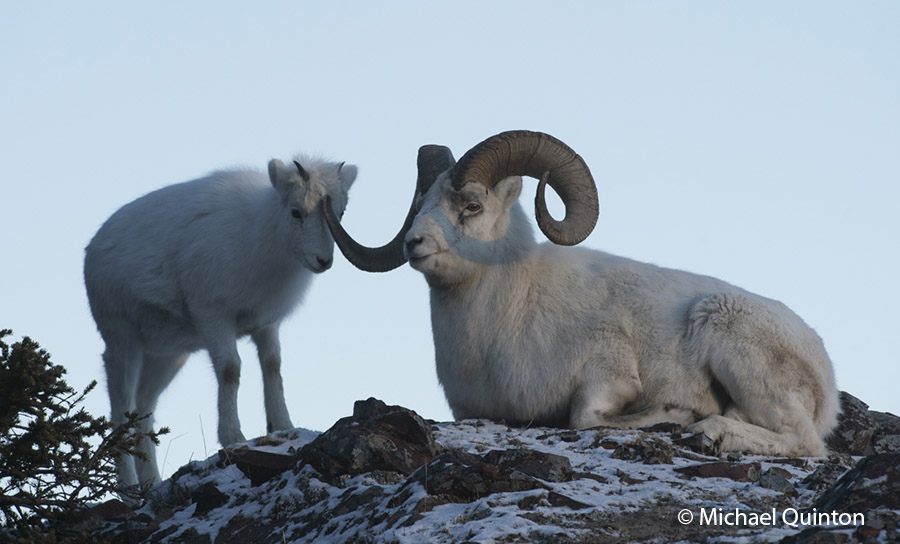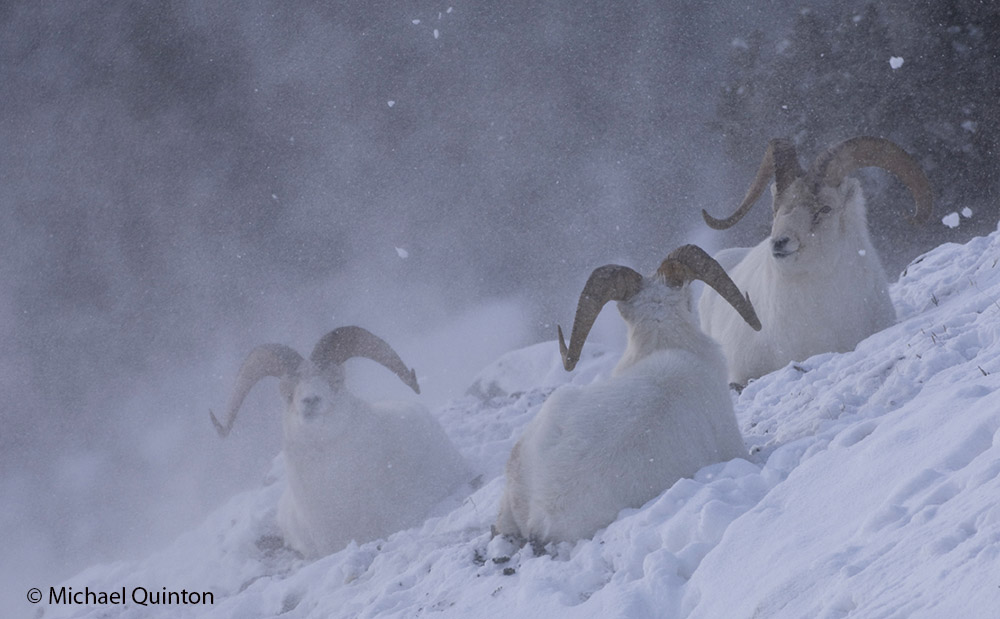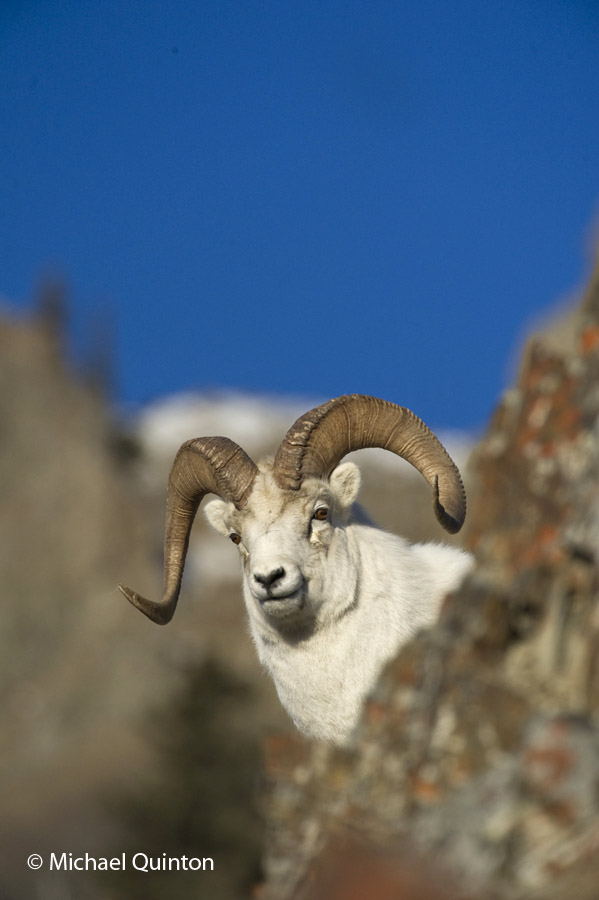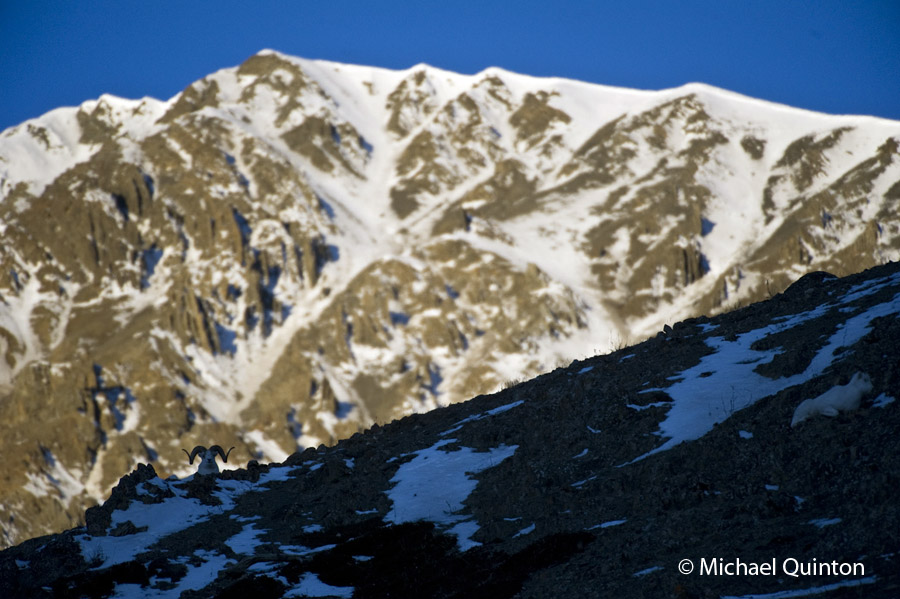https://youtu.be/9ewR7-Rgeis
1850 still photos into a one minute video.
https://youtu.be/ZiuzOzNt80g
Each winter dall sheep migrate to their rugged, windswept slopes. It is here that their dramatic rut takes place.

https://youtu.be/9ewR7-Rgeis
1850 still photos into a one minute video.
https://youtu.be/ZiuzOzNt80g
Each winter dall sheep migrate to their rugged, windswept slopes. It is here that their dramatic rut takes place.
 “Some day I’m going to be king of this mountain.”
“Some day I’m going to be king of this mountain.”
Once again I have made the trek into the sheep hills to photograph the majestic dall sheep. Its getting tougher, the mountains bigger, but fear if I ever quite, I’ll probably just keel over.
As I struggled up the mountainside towards the distant white dots, I paused on the edge of a deep canyon to catch my breath. From across the canyon and out of the deep green of the spruce forest came a shrill screaming. Sounding like the death scream of a snowshoe hare, just not quite. I had an idea what was making that sound. An hour later I stood among a group of ewes and lambs. Suddenly the whole herd spooked. They dashed to a ridge top and stared back down. Continue reading
All summer and fall dall rams have shunned the groups of ewes and lambs. The rams prefer the high country where they hang out in small bachelor bands. With the approach of winter their association begins to fray as they begin to sort out a pecking order. The rams stand in tight groups, displaying their massive curls trying to intimidate. They kick, growl, shove, and finally engage in dramatic displays of head butting. For the most part dominance has been been sorted out when they join the herds of ewes and lambs already on the winter range. Dall rams Continue reading
Dall rams Continue reading
ONE OF MY FAVORITE PHOTOGRAPHIC SUBJECTS, DALL SHEEP
 Spectacular Wrangell Mountains in Alaska seem insignificant in this ineffective wide-angle photograph.
Spectacular Wrangell Mountains in Alaska seem insignificant in this ineffective wide-angle photograph.
I remember my own fascination with the wide-angle lens. My first was a 24mm. The wide view had great appeal to me. It was thrilling to look at the landscape thru my lens. I could fit entire mountain ranges onto my tiny Kodachrome slide! And there lies the problem. A wide-angle lens often includes too much information with detail that is too small.
We expect the camera to record what we see. But, the fact is, we humans see things quite differently than any camera. Humans see their subject subjectively. We concentrate on our subject and don’t notice much else, missing details that we should be paying close attention to.
The camera records everything within the viewfinder, it sees objectively. Right down to all those distracting details we failed to notice.
In contrast, when we look at a mountain range or desert, we see the mountains, the terrain, we feel the wind, we get dust in our eye, we feel the cold or hot, We smell the pines or the sagebrush and the delicate fragrance of wildflowers as our gaze dances from flower to flower and bounce along with a foraging bumble bee.
 Dall ram checks out photographer.
Dall ram checks out photographer.
Walk softly and carry a big lens. All species of North American mountain sheep, the bighorns, Rocky Mountain bighorn and desert bighorn and the thinhorns, stone sheep and dall sheep are naturally skittish. Specific protocols are required when photographing wild sheep at close range. Ever on the lookout for predators, wild sheep are tuned into sounds of rocks tumbling down the mountainsides or moving across noisy scree slopes. Sudden movements or too much noise are likely to send mountain sheep stampeding towards the nearest cliffs. A telephoto lens is a must. The perspective a telephoto gives will separate your subject from the background. Continue reading
 Dall ram peeks over a windswept ridge.
Dall ram peeks over a windswept ridge.
Pursuing wild rams in the far north is an addiction of mine. Those who are afflicted with this particular disease willingly subject themselves to cold and wind, sweat and pain. Other symptoms include an insatiable desire to witness dramatic wildlife amid glorious wilderness settings. Continue reading
CURIOSITY
 Curiosity, pure and simple, the kind my two year old grandaughter is full of, is an essential element for the creative photo naturalist
Curiosity, pure and simple, the kind my two year old grandaughter is full of, is an essential element for the creative photo naturalist
THE PHOTO NATURALIST
Welcome to my new blog, THE PHOTO NATURALIST. I hope to share what little I have learned from forty years as a professional wildlife photographer.
Nature photography is nothing new, it’s been around for onehundred and sixty five years. George Eastman’s camera was manufactured in 1888. Pre-loaded with one hundred exposures, the Kodak Brownie had to be returned to the factory for processing and reloading. For the first time photography was available to everyone. Continue reading